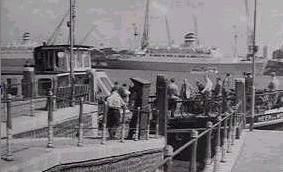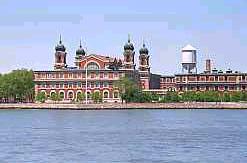
![]()
ms Rijndam
I never voluntarily looked for ships which were on a regular service from point A to point B. I still was a bachelor and preferred to join ships of the "Never Come Home Line" as it was called. But exceptions had to be made either because one could not keep refusing urgent offers from the office or that some time had to be killed on regular line ships prior to a planned summer furlough for instance. In those days there still was a heavy passenger trade from Rotterdam to New York.
Rather than design and build new ships from scratch, H.A.L. decided to redesign the freighter DINTELDYK as a liner, the ms Rijndam. And on top of that immediately lay the keel for a sistership, the ms Maasdam. On 30th October 1950 the Line's Director Willem H. de Monchy announced in Rotterdam that DINTELDYK would be renamed RYNDAM (II) and enter service on the Rotterdam-Channel Ports-Southampton-New York run that following summer with a sister named MAASDAM (IV) coming in 1952. Both ships would introduce a revolutionary two-class layout favouring Tourists. The idea was very new and revolutionary for those days.
Furthermore I also served as a 3rd Radio Officer on the sister of the Rijndam, the ms Maasdam and attended the sea trials of the ms Prinsendam, ss Veendam (ex s.s. Argentina) and ss Volendam (ex s.s. Brasil).
Both sister ships "Maasdam" and "Rijndam" can be seen here at the Holland America Line terminal in New York. For many years this terminal was the gateway to the United States for a lot of people. I can not tell from this picture which ship is which. One of the ships is just leaving the terminal. I judge that from the tugboat's position - pushing full throttle away from the terminal - and the tell tale signs as can be seen from turbulent reverse screw's wake moving to the front of the ship both on the port and starboard side.

Another picture in which both ships are berthed together in a sisterly fashion, only this time at the Holland America Line terminal in Rotterdam, the other end of the line! Once again I cannot tell which one is which. The small ferry boat in front used to shuttle from this side of the river first to Katendrecht and then to the H.A.L. pier and back again. I used this ferry when going to sea for the first time in august 1954. The Sibajak was lying then alongside the H.A.L. terminal, at the Wilhelmina Quay as it is called. It is high water in the river as the upper slope is used here to leave and board the ship.
The ms Rijndam was in service from 1951 - 1966 (15.015) and was transferred to the German subsidiary Europa-Canada Linie, Bremen, 1967 transferred to Trans-Oceaan, Rotterdam renamed Waterman, 1967 reverted to HAL renamed Ryndam, 1972 sold to World Wide Cruises, Panama renamed Atlas. The rather funny looking funnel is the Strombos Aerofoil first fitted on the French liner PRESIDENT DE CAZALET in April 1950. The wafer thin Strombos reduced wind resistance with the slipstream carrying-away the smoke. Last week (beginning of April, 2003) there was a short message in a local newspaper that the ms Rijndam had sunk when being towed to the scrap yard some where in the Far East. I will try to find some more specifics on that. May be this proud lady chose not to be broken up in many pieces and decided that a seaman's burial after such a long service on the Seven Seas was her well earned right. Good for her and really first class! May she rest in peace.

Built by Wilton-Fijenoord, Schiedam(15015grt; 153x21m; 16,5kn; 893 passengers in 2 classes). Sailed in Rotterdam-New York/Montreal services + cruises. Named WATERMAN 1968. Subsequent names RYNDAM 1968; ATLAS 1973; PRIDE OF MISSISSIPPI 1988; PRIDE OF GALVESTON 1991; COPA CASINO 1992. Permanently moored at Gulfport (USA)). Sister ship: MAASDAM.

The first ss Rotterdam was built by Harlan & Wolff Limited, Belfast, Northern Ireland, 1901. 12,527 gross tons; 575 (bp) feet long; 62 feet wide. Steam triple expansion engines, twin screw. Service speed 15 knots. 2,282 passengers (286 first class, 196 second class, 1,800 third class). Exclusively built for the Rotterdam-New York service. Laid up in 1917 due to World War I and then chartered by United States Navy, American flag, in 1918. Used as a troopship for about a year bringing back the troops from Europe to the U.S. Continued in the Rotterdam-New York service from 1919 - 1928. Scrapped in Holland in 1929.

A great many new Americans arrived with the first ss Rijndam in New York and entered the United States through the Ellis Island portal. Between 1892 and 1924, over 22 million people entered here, and their records can now be retrieved at the following web site: http://www.ellisislandrecords.org/
Both the ms Rijndam and ms Maasdam were originally designed as freighters and later on the design was changed to that of a passenger ship. Truth is that during bad weather conditions both ships behaved terrible. Almost all passengers were seasick during most of the Atlantic passage. A rather high gravity point because of the changes made during the redesign of the freighter hulls could explain the extreme swinging motions of the ships. The radio room was located on the upper boat deck, where the motions were especially being felt. When receiving the American press during the night watch - as the third radio officer you could count on it that the so called 'dog watch' was yours - I had to slide into the chair which was securely tied with ropes to the table on which the typewriter was situated. I remember one especially rough North Atlantic crossing in which all the furniture and the saloons were smashed. To me that was a funny situation as the furniture obviously had not been tied down to the deck. On the tankers I used to sail on everything was securely tied down, especially when bad weather was expected. One of the deck officers had been making a round over the ship to establish the damage and tried to raise interest with the hotel department in order to start some damage control, but in vain it seemed. Things had to quiet down first. The wave stabilizers, a kind of fins protruding from the sides of the ships, which were steered so to counteract the ship's motions, seemingly induced a lot of forces into the ships when in bad weather. So it could happen that toilet pots and also large mirrors broke spontaneously, a phenomena which I had never encountered before and after being on those ships. For the rest these rather small - also called the Atlantic's Great Little Liners - passenger ships were of a beautiful design, well lined and far away from the sailing high rise buildings of these days.
Some
links for further information:
http://freepages.genealogy.rootsweb.com/~maxfield/hennebohle/NASM1882.html
Posters! http://www.kinshipsprints.com/catalog/advart/nasm.htm
Advertising Art (NASM) http://www.hollandamerica.com/
http://unofficial.net/hal/maas4.html
http://unofficial.net/hal/kohler.html
The Atlantic's "Great Little Liners" ms Rijndam and ms Maasdam